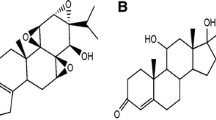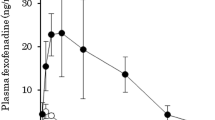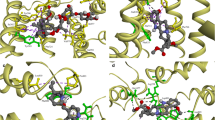Abstract
Digoxin is a drug with a narrow therapeutic index, which is a substrate of the ATP-dependent efflux pump P-glycoprotein. Increased or decreased digoxin plasma concentrations occur in humans due to the inhibition or induction of this drug transporter in organs with excretory function such as small intestine, liver and kidney. It is well known that serum concentrations of digoxin increase considerably in humans if propafenone is given simultaneously. However, it has not been investigated in detail whether propafenone and its metabolites are substrates and/or inhibitors of human P-glycoprotein. The aim of this study, therefore, was to investigate the P-glycoprotein-mediated transport and inhibition properties of propafenone and its major metabolites 5-hydroxypropafenone and N-desalkylpropafenone in Caco-2 cell monolayers. Inhibition of P-glycoprotein-mediated transport by propafenone and its metabolites was determined using digoxin as a P-glycoprotein substrate. No polarised transport was observed for propafenone and N-desalkylpropafenone in Caco-2 cell monolayers. However, 5-hydroxypropafenone translocation was significantly greater from basal-to-apical compared with apical-to-basal (Papp basal–apical vs. Papp apical–basal, 10.21±2.63×10−6 vs. 4.34±1.84×10−6 cm/s; P<0.01). Moreover, propafenone, 5-hydroxypropafenone and N-desalkylpropafenone inhibited P-glycoprotein-mediated digoxin transport with IC50 values of 6.8, 19.9, and 21.3 μM, respectively. In summary, whereas propafenone and N-desalkylpropafenone are not substrates of P-glycoprotein, 5-hydroxypropafenone is translocated by human P-glycoprotein across cell monolayers. In addition, propafenone and its two major metabolites 5-hydroxypropafenone and N-desalkylpropafenone are inhibitors of human P-glycoprotein and therefore contribute to the digoxin–propafenone interaction observed in humans.



Similar content being viewed by others
References
Alboni P, Botto GL, Baldi N, Luzi M, Russo V, Gianfranchi L, Marchi P, Calzolari M, Solano A, Baroffio R, Gaggioli G (2004) Outpatient treatment of recent-onset atrial fibrillation with the “pill-in-the-pocket” approach. N Engl J Med 351:2384–2391
Arboix M, Paz OG, Colombo T, D’Incalci M (1997) Multidrug resistance-reversing agents increase vinblastine distribution in normal tissues expressing the P-glycoprotein but do not enhance drug penetration in brain and testis. J Pharmacol Exp Ther 281:1226–1230
Artursson P, Palm K, Luthman K (2001) Caco-2 monolayers in experimental and theoretical predictions of drug transport. Adv Drug Deliv Rev 46:27–43
Belz GG, Doering W, Munkes R, Matthews J (1983) Interaction between digoxin and calcium antagonists and antiarrhythmic drugs. Clin Pharmacol Ther 33:410–417
Bigot MC, Debruyne D, Bonnefoy L, Grollier G, Moulin M, Potier JC (1991) Serum digoxin levels related to plasma propafenone levels during concomitant treatment. J Clin Pharmacol 31:521–526
Botsch S, Gautier JC, Beaune P, Eichelbaum M, Kroemer HK (1993) Identification and characterization of the cytochrome P450 enzymes involved in N-dealkylation of propafenone: molecular base for interaction potential and variable disposition of active metabolites. Mol Pharmacol 43:120–126
Bryson HM, Palmer KJ, Langtry HD, Fitton A (1993) Propafenone. A reappraisal of its pharmacology, pharmacokinetics and therapeutic use in cardiac arrhythmias. Drugs 45:85–130
Calvo MV, Martin-Suarez A, Martin Luengo C, Avila C, Cascon M, Dominguez-Gil Hurle A (1989) Interaction between digoxin and propafenone. Ther Drug Monit 11:10–15
Candinas R, Gloor HO, Lindner W, Ha HR, Buchinger W, Amann FW, Follath F (1996) Are there stereoselective electrophysiologic effects of intravenously administered (S)- or (R)-propafenone hydrochloride in patients with supraventricular tachycardia? Eur J Clin Pharmacol 50:185–190
Chiba P, Ecker G, Schmid D, Drach J, Tell B, Goldenberg S, Gekeler V (1996) Structural requirements for activity of propafenone-type modulators in P-glycoprotein-mediated multidrug resistance. Mol Pharmacol 49:1122–1130
Doering W (1979) Quinidine–digoxin interaction: pharmacokinetics, underlying mechanism and clinical implications. N Engl J Med 301:400–404
Evans DA, Mahgoub A, Sloan TP, Idle JR, Smith RL (1980) A family and population study of the genetic polymorphism of debrisoquine oxidation in a white British population. J Med Genet 17:102–105
Fromm MF (2000) P-glycoprotein: a defense mechanism limiting oral bioavailability and CNS accumulation of drugs. Int J Clin Pharmacol Ther 38:69–74
Fromm MF, Botsch S, Heinkele G, Evers J, Kroemer HK (1995) Influence of renal function on the steady-state pharmacokinetics of the antiarrhythmic propafenone and its phase I and phase II metabolites. Eur J Clin Pharmacol 48:279–283
Fromm MF, Kim RB, Stein CM, Wilkinson GR, Roden DM (1999) Inhibition of P-glycoprotein-mediated drug transport: a unifying mechanism to explain the interaction between digoxin and quinidine. Circulation 99:552–557
Funck-Brentano C, Kroemer HK, Pavlou H, Woosley RL, Roden DM (1989) Genetically-determined interaction between propafenone and low dose quinidine: role of active metabolites in modulating net drug effect. Br J Clin Pharmacol 27:435–444
Funck-Brentano C, Kroemer HK, Lee JT, Roden DM (1990) Propafenone. N Engl J Med 22:518–525
Gonzalez FJ, Skoda RC, Kimura S, Umeno M, Zanger UM, Nebert DW, Gelboin HV, Hardwick JP, Meyer UA (1988) Characterization of the common genetic defect in humans deficient in debrisoquine metabolism. Nature 331:442–446
Greiner B, Eichelbaum M, Fritz P, Kreichgauer HP, von Richer O, Zundler J, Kroemer HK (1999) The interaction of digoxin and rifampin: role of intestinal P-glycoprotein. J Clin Invest 104:147–153
Hofmann U, Pecia M, Heinkele G, Dilger K, Kroemer HK, Eichelbaum M (2000) Determination of propafenone and its phase I and phase II metabolites in plasma and urine by high-performance liquid chromatography-electrospray ionization mass spectrometry. J Chromatogr B Biomed Sci Appl 748:113–123
Ingels FM, Augustijns PF (2003) Biological, pharmaceutical, and analytical considerations with respect to the transport media used in the absorption screening system, Caco-2. J Pharm Sci 92:1545–1558
Kim RB, Fromm MF, Wandel C, Leake B, Wood AJ, Roden DM, Wilkinson GR (1998) The drug transporter P-glycoprotein limits oral absorption and brain entry of HIV-1 protease inhibitors. J Clin Invest 101:289–294
Kivistö KT, Zukunft J, Hofmann U, Niemi M, Rekersbrink S, Schneider S, Luippold G, Schwab M, Eichelbaum M, Fromm MF (2004) Characterisation of cerivastatin as a P-glycoprotein substrate: studies in P-glycoprotein-expressing cell monolayers and mdr1a/b knock-out mice. Naunyn-Schmiedebergs Arch Pharmacol 370:124–130
Kroemer HK, Funck-Brentano C, Silberstein DJ, Wood AJ, Eichelbaum M, Woosley RL, Roden DM (1989) Stereoselective disposition and pharmacologic activity of propafenone enantiomers. Circulation 79:1068–1076
Kroemer HK, Fischer C, Meese CO, Eichelbaum M (1991) Enantiomer/enantiomer interaction of (S)- and (R)-propafenone for cytochrome P450IID6-catalyzed 5-hydroxylation: in vitro evaluation of the mechanism. Mol Pharmacol 40:135–142
Kroemer HK, Fromm MF, Bühl K, Terefe H, Blaschke G, Eichelbaum M (1994) An enantiomer–enantiomer interaction of (S)- and (R)-propafenone modifies the effect of racemic drug therapy. Circulation 89:2396–2400
Nolan PE Jr, Marcus FI, Erstad BL, Hoyer GL, Furman C, Kirsten EB (1989) Effects of coadministration of propafenone on the pharmacokinetics of digoxin in healthy volunteer subjects. J Clin Pharmacol 29:46–52
Page RL (2004) Clinical practice. Newly diagnosed atrial fibrillation. N Engl J Med 351:2408–2416
Pauli-Magnus C, Mürdter T, Godel A, Mettang T, Eichelbaum M, Klotz U, Fromm MF (2001) P-glycoprotein-mediated transport of digitoxin, alpha-methyldigoxin and beta-acetyldigoxin. Naunyn-Schmiedebergs Arch Pharmacol 363:337–343
Pleban K, Hoffer C, Kopp S, Peer M, Chiba P, Ecker GF (2004) Intramolecular distribution of hydrophobicity influences pharmacological activity of propafenone-type MDR modulators. Arch Pharm (Weinheim) 337:328–334
Propafenone product information. (2003) Sandoz, Basel, Switzerland
Salerno DM, Granrud G, Sharkey P, Asinger R, Hodges M (1984) A controlled trial of propafenone for treatment of frequent and repetitive ventricular premature complexes. Am J Cardiol 53:77–83
Schinkel AH, Wagenaar E, van Deemter L, Mol CA, Borst P (1995) Absence of the mdr1a P-Glycoprotein in mice affects tissue distribution and pharmacokinetics of dexamethasone, digoxin, and cyclosporin A. J Clin Invest 96:1698–1705
Schmid D, Ecker G, Kopp S, Hitzler M, Chiba P (1999) Structure–activity relationship studies of propafenone analogs based on P-glycoprotein ATPase activity measurements. Biochem Pharmacol 58:1447–1456
Schmid D, Staudacher DL, Loew HG, Spieckermann PG, Ecker GF, Kopp S, Chiba P (2003) A subset of highly effective propafenone-type multidrug resistance modulators lacks effects on cardiac action potential and mechanical twitch parameters of rat papillary muscles. J Pharmacol Exp Ther 307:589–596
Schwabe U, Paffrath D (eds) (2003) Arzneiverordnungsreport. Springer-Verlag Berlin Heidelberg New York, pp 125–130
Siddoway LA, Thompson KA, McAllister CB, Wang T, Wilkinson GR, Roden DM, Woosley RL (1987) Polymorphism of propafenone metabolism and disposition in man: clinical and pharmacokinetic consequences. Circulation 75:785–791
Spes CH, Angermann CE, Horn K, Strasser T, Mudra H, Landgraf R, Theisen K (1990) Cilosporin–propafenone interaction. Klin Wochenschr 68:872
UK Propafenone PSVT Study Group (1995) A randomized, placebo-controlled trial of propafenone in the prophylaxis of paroxysmal supraventricular tachycardia and paroxysmal atrial fibrillation. Circulation 92:2550–2557
Woodland C, Verjee Z, Giesbrecht E, Koren G, Ito S (1997) The digoxin–propafenone interaction: characterization of a mechanism using renal tubular cell monolayers. J Pharmacol Exp Ther 283:39–45
Zalzstein E, Koren G, Bryson SM, Freedom RM (1990) Interaction between digoxin and propafenone in children. J Pediatr 116:310–312
Acknowledgements
We are grateful to Mrs. Monika Seiler for expert technical assistance. This work was supported by the Robert Bosch Foundation (Stuttgart, Germany) and the Deutsche Forschungsgemeinschaft (Fr 1298/2-3, Bonn, Germany).
Author information
Authors and Affiliations
Corresponding author
Rights and permissions
About this article
Cite this article
Bachmakov, I., Rekersbrink, S., Hofmann, U. et al. Characterisation of (R/S)-propafenone and its metabolites as substrates and inhibitors of P-glycoprotein. Naunyn-Schmiedeberg's Arch Pharmacol 371, 195–201 (2005). https://doi.org/10.1007/s00210-005-1025-y
Received:
Accepted:
Published:
Issue Date:
DOI: https://doi.org/10.1007/s00210-005-1025-y




